Separation of α-Lactalbumin Enriched Fraction from Bovine Native Whey Concentrate by Combining Membrane and High-Pressure Processing
Abstract
1. Introduction
2. Materials and Methods
2.1. Milk and Whey Samples
2.2. Chemicals and Standards
2.3. Proximate Composition Parameters
2.4. High Pressure Processing
2.5. HPLC Quantification of the Proteins
2.6. Process Performance Parameters
2.7. Hydrophobicity Index
2.8. Total Free Thiol Groups Index
2.9. SDS-PAGE
2.10. Statistics
3. Results and Discussion
3.1. First Set of Experiments
3.2. Second Set of Experiments
3.2.1. Main Process Performance Parameters
3.2.2. Total Free Thiol Groups Index (TFTi)
3.2.3. Hydrophobicity Index
3.2.4. SDS-PAGE
4. Conclusions
Supplementary Materials
Author Contributions
Funding
Data Availability Statement
Acknowledgments
Conflicts of Interest
References
- Eurostat. Agriculture, Forestry and Fishery Statistics. In Milk and Milk Products Statistics; Cook, E., Ed.; Publications Office of the European Union: Luxembourg, 2020; pp. 57–64. [Google Scholar]
- Rocha-Mendoza, D.; Kosmerl, E.; Krentz, A.; Zhang, L.; Miyagusuku-cruzado, G.; Mayta-apaza, A.; Giusti, M.; García-cano, I.; Badiger, S.; Jiménez-flores, R. Invited review: Acid whey trends and health benefits. J. Dairy Sci. 2021, 104, 1262–1275. [Google Scholar] [CrossRef] [PubMed]
- Brandelli, A.; Daroit, D.J.; Corrêa, A.P.F. Whey as a source of peptides with remarkable biological activities. Food Res. Int. 2015, 73, 149–161. [Google Scholar] [CrossRef]
- Herreman, L.; Nommensen, P.; Pennings, B.; Laus, M.C. Comprehensive overview of the quality of plant- And animal-sourced proteins based on the digestible indispensable amino acid score. Food Sci. Nutr. 2020, 8, 5379–5391. [Google Scholar] [CrossRef] [PubMed]
- Augustin, M.A.; Hemar, Y. Nano- and micro-structured assemblies for encapsulation of food ingredients. Chem. Soc. Rev. 2009, 38, 902–912. [Google Scholar] [CrossRef] [PubMed]
- Oancea, A.; Aprodu, I.; Otilia, I.; Barbu, V.; Bahrim, G.; Gabriela, R. A bottom-up approach for encapsulation of sour cherries anthocyanins by using b-lactoglobulin as matrices. J. Food Eng. 2017, 210, 83–90. [Google Scholar] [CrossRef]
- Corrêa, A.P.F.; Daroit, D.J.; Fontoura, R.; Meira, S.M.M.; Segalin, J.; Brandelli, A. Hydrolysates of sheep cheese whey as a source of bioactive peptides with antioxidant and angiotensin-converting enzyme inhibitory. Peptides. 2016, 61, 48–55. [Google Scholar] [CrossRef] [PubMed]
- Madureira, A.R.; Tavares, T.; Gomes, A.M.P.; Pintado, M.E.; Malcata, F.X. Invited review: Physiological properties of bioactive peptides obtained from whey proteins. J. Dairy Sci. 2010, 93, 437–455. [Google Scholar] [CrossRef]
- Jauregi, P.; Olatujoye, J.; Cabezudo, I.; Frazier, R.A.; Gordon, M.H. Astringency reduction in red wine by whey proteins. Food Chem. 2016, 199, 547–555. [Google Scholar] [CrossRef]
- Pires, A.F.; Marnotes, N.G.; Rubio, O.D.; Garcia, A.C.; Pereira, C.D. Dairy By-Products: A Review on the Valorization of Whey and Second Cheese Whey. Foods 2021, 10, 1067. [Google Scholar] [CrossRef]
- Muuronen, K.; Partanen, R.; Heidebrecht, H.; Kulozik, U. Effects of conventional processing methods on whey proteins in production of native whey powder. Int. Dairy J. 2021, 116, 104959. [Google Scholar] [CrossRef]
- Tsermoula, P.; Khakimov, B.; Nielsen, J.H.; Engelsen, S.B. WHEY—The waste-stream that became more valuable than the food product. Trends Food Sci. Technol. 2021, 118, 230–241. [Google Scholar] [CrossRef]
- Madureira, A.R.; Pereira, C.I.; Gomes, A.M.P.; Pintado, M.E.; Malcata, X.F. Bovine whey proteins—Overview on their main biological properties. Food Res. Int. 2007, 40, 1197–1211. [Google Scholar] [CrossRef]
- Keppler, J.K.; Heyse, A.; Scheidler, E.; Uttinger, M.J.; Fitzner, L.; Jandt, U.; Heyn, T.R.; Lautenbach, V.; Loch, J.I.; Lohr, J.; et al. Towards recombinantly produced milk proteins: Physicochemical and emulsifying properties of engineered whey protein beta-lactoglobulin variants. Food Hydrocoll. 2021, 110, 106132. [Google Scholar] [CrossRef]
- Gottschalk, M.; Nilsson, H.; Roos, H.; Halle, B. Protein self-association in solution: The bovine beta-lactoglobulin dimer and octamer. Protein Sci. 2003, 12, 2404–2411. [Google Scholar] [CrossRef] [PubMed]
- Natale, M.; Bisson, C.; Monti, G.; Peltran, A. Cow’s milk allergens identification by two-dimensional immunoblotting and mass spectrometry. Mol. Nutr. Food Res. 2004, 48, 363–369. [Google Scholar] [CrossRef]
- Kurpiewska, K.; Biela, A.; Loch, J.I.; Lipowska, J.; Siuda, M. Towards understanding the effect of high pressure on food protein allergenicity: B-lactoglobulin structural studies. Food Chem. 2019, 270, 315–321. [Google Scholar] [CrossRef]
- Barone, G.; Moloney, C.; Regan, J.O.; Kelly, A.L.; Mahony, J.A.O. Chemical composition, protein profile and physicochemical properties of whey protein concentrate ingredients enriched in a-lactalbumin. J. Food Compos. Anal. 2020, 92, 103546. [Google Scholar] [CrossRef]
- Schlatterer, B.; Baeker, R.; Schlatterer, K. Improved purification of b-lactoglobulin from acid whey by means of ceramic hydroxyapatite chromatography with sodium fluoride as a displacer. J. Chromatogr. B 2004, 807, 223–228. [Google Scholar] [CrossRef]
- Fuciños, C.; Fuciños, P.; Estévez, N.; Pastrana, L.M.; Vicente, A.A.; Luisa, M. One-step chromatographic method to purify a-lactalbumin from whey for nanotube synthesis purposes. Food Chem. 2019, 275, 480–488. [Google Scholar] [CrossRef]
- Lozano, J.M.; Giraldo, G.I.; Romero, C.M. An improved method for isolation of b-lactoglobulin. Int. Dairy J. 2008, 18, 55–63. [Google Scholar] [CrossRef]
- Haller, N.; Kulozik, U. Continuous centrifugal separation of selectively precipitated a-lactalbumin. Int. Dairy J. 2020, 101, 104566. [Google Scholar] [CrossRef]
- Konrad, G.; Kleinschmidt, T. A new method for isolation of native a-lactalbumin from sweet whey. Int. Dairy J. 2008, 18, 47–54. [Google Scholar] [CrossRef]
- Cheison, S.C.; Leeb, E.; Toro-Sierra, J.; Kulozik, U. Influence of hydrolysis temperature and pH on the selective hydrolysis of whey proteins by trypsin and potential recovery of native alpha-lactalbumin. Int. Dairy J. 2011, 21, 166–171. [Google Scholar] [CrossRef]
- Holland, B.; Kackmar, J.; Corredig, M. Short communication: Isolation of a whey fraction rich in a-lactalbumin from skim milk using tangential flow ultrafiltration. J. Dairy Sci. 2012, 95, 5604–5607. [Google Scholar] [CrossRef] [PubMed]
- Carter, B.; Dimarzo, L.; Pranata, J.; Barbano, D.M.; Drake, M. Determination of the efficiency of removal of whey protein from sweet whey with ceramic microfiltration membranes. J. Dairy Sci. 2021, 104, 7534–7543. [Google Scholar] [CrossRef] [PubMed]
- Kaur, N.; Sharma, P.; Jaimni, S.; Kehinde, B.A.; Kaur, S. Recent developments in purification techniques and industrial applications for whey valorization: A review. Chem. Eng. Commun. 2020, 207, 123–138. [Google Scholar] [CrossRef]
- Huang, H.; Wu, S.; Lu, J.; Shyu, Y.; Wang, C. Current status and future trends of high-pressure processing in food industry. Food Control 2017, 72, 1–8. [Google Scholar] [CrossRef]
- Pou, J.K.R. Applications of High Pressure Technology in Food Processing. Int. J. Food Stud. 2021, 10, 248–281. [Google Scholar] [CrossRef]
- Carullo, D.; Barbosa-Cánovas, G.V.; Ferrari, G. Changes of structural and techno-functional properties of high hydrostatic pressure (HHP) treated whey protein isolate over refrigerated storage. LWT 2021, 137, 110436. [Google Scholar] [CrossRef]
- López-Fandiño, R.; Carrascosa, A.V.; Olano, A. The Effects of High Pressure on Whey Protein Denaturation and Cheese-Making Properties of Raw Milk. J. Dairy Sci. 1996, 79, 929–936. [Google Scholar] [CrossRef]
- Patel, H.A.; Singh, H.; Anema, S.G.; Creamer, L.K. Effects of Heat and High Hydrostatic Pressure Treatments on Disulfide Bonding Interchanges among the Proteins in Skim Milk. J. Agric. Food Chem. 2006, 54, 3409–3420. [Google Scholar] [CrossRef] [PubMed]
- Brew, K. a-Lactalbumin. In Advanced Dairy Chemistry—1 Proteins; Fox, P.F., McSweeney, P.L.H., Eds.; Springer: Boston, MA, USA, 2003; pp. 387–419. [Google Scholar] [CrossRef]
- Edwards, P.J.B.; Jameson, G.B. Chapter 7—Structure and stability of whey proteins. In Milk Proteins: From Expression to Food, 3rd ed.; Boland, M., Singh, H., Eds.; Academic Press: San Diego, CA, USA, 2020. [Google Scholar] [CrossRef]
- Huppertz, T.; Fox, P.F.; Kelly, A.L. High pressure-induced denaturation of a-lactalbumin and b-lactoglobulin in bovine milk and whey: A possible mechanism. J. Dairy Res. 2004, 71, 489–495. [Google Scholar] [CrossRef] [PubMed]
- Marciniak, A.; Suwal, S.; Touhami, S.; Chamberland, J.; Pouliot, Y.; Doyen, A. Production of highly purified fractions of a-lactalbumin and b-lactoglobulin from cheese whey using high hydrostatic pressure. J. Dairy Sci. 2020, 103, 7939–7950. [Google Scholar] [CrossRef]
- Touhami, S.; Chamberland, J.; Perreault, V.; Suwal, S.; Marciniak, A.; Pouliot, Y.; Doyen, A. Coupling high hydrostatic pressure and ultrafiltration for fractionation of alpha-lactalbumin from skim milk. Sep. Sci. Technol. 2021, 56, 1102–1111. [Google Scholar] [CrossRef]
- Pouliot, Y. Membrane processes in dairy technology-From a simple idea to worldwide panacea. Int. Dairy J. 2008, 18, 735–740. [Google Scholar] [CrossRef]
- Kolakowski, P.; Dumay, E.; Cheftel, J.C. Effects of high pressure and low temperature on b-lactoglobulin unfolding and aggregation. Food Hydrocoll. 2001, 15, 215–232. [Google Scholar] [CrossRef]
- Zobrist, M.R.; Huppertz, T.; Uniacke, T.; Fox, P.F.; Kelly, A.L. High-pressure-induced changes in the rennet coagulation properties of bovine milk. Int. Dairy J. 2005, 15, 655–662. [Google Scholar] [CrossRef]
- Goyal, A.; Sharma, V.; Upadhyay, N.; Sihag, M.; Kaushik, R. High Pressure Processing and Its Impact on Milk Proteins: A Review. J. Dairy Sci. Technol. 2013, 2, 2319–3409. [Google Scholar]
- ISO 1211:2010 | IDF 1:2010; Milk—Determination of Fat Content—Gravimetric Method (Reference Method). International Organization for Standardization: Geneva, Switzerland, 2010.
- ISO 8968-3:2004 | IDF 20-3:2004; Milk—Determination of Nitrogen Content—Part 3: Block-Digestion Method (Semi-Micro Rapid Routine Method). International Organization for Standardization: Geneva, Switzerland, 2004.
- ISO 2920:2004 | IDF 58:2004; Whey Cheese—Determination of Dry Matter (Reference Method). International Organization for Standardization: Geneva, Switzerland, 2004.
- BOE-A-1977-16116. Orden de 31 de Enero de 1977 por la que se Establecen los Métodos Oficiales de Análisis de Aceites y Grasas, Cereales y Derivados, Productos Lácteos y Productos Derivados de la Uva. Available online: https://www.boe.es/eli/es/o/1977/01/31/(1) (accessed on 20 December 2022).
- Steen, L.; Glorieux, S.; Goemaere, O.; Brijs, K.; Paelinck, H.; Foubert, I.; Fraeye, I. Functional Properties of Pork Liver Proteins Fractions. Food Bioproc. Technol. 2016, 9, 970–980. [Google Scholar] [CrossRef]
- Yongsawatdigul, J.; Parke, J.W. Thermal denaturation and aggregation of threadfin bream actomyosin. Food Chem. 2003, 83, 409–416. [Google Scholar] [CrossRef]
- Considine, T.; Patel, H.A.; Anema, S.G.; Singh, H.; Creamer, L.K. Interactions of milk proteins during heat and high hydrostatic pressure treatments—A Review. Innov. Food Sci. Emerg. Technol. 2007, 8, 1–23. [Google Scholar] [CrossRef]
- Huppertz, T.; Fox, P.F.; de Kruif, K.G.; Kelly, A.L. High pressure-induced changes in bovine milk proteins: A review. Biochim. Biophys. Acta Proteins Proteom. 2006, 1764, 593–598. [Google Scholar] [CrossRef]
- Marciniak, A.; Suwal, S.; Britten, M.; Pouliot, Y.; Doyen, A. The use of high hydrostatic pressure to modulate milk protein interactions for the production of an alpha-lactalbumin enriched-fraction. Green Chem. 2018, 20, 515–524. [Google Scholar] [CrossRef]
- Anema, S.G.; Stockmann, R.; Lowe, E.K. Denaturation of b-lactoglobulin in pressure-treated skim milk. J. Agric. Food Chem. 2005, 53, 7783–7791. [Google Scholar] [CrossRef] [PubMed]
- Hinrichs, J.; Rademacher, B. High pressure thermal denaturation kinetics of whey proteins. J. Dairy Res. 2004, 71, 480–488. [Google Scholar] [CrossRef] [PubMed]
- Patel, H.A. Studies on Heat-and Pressure-Induced Interactions of Milk Proteins. Ph.D. Thesis, Massey University, Palmerston North, New Zeland, 2007. [Google Scholar]
- Ambrosi, V.; Polenta, G.; Gonzalez, C.; Ferrari, G.; Maresca, P. High hydrostatic pressure assisted enzymatic hydrolysis of whey proteins. Innov. Food Sci. Emerg. Technol. 2016, 38, 294–301. [Google Scholar] [CrossRef]
- Anema, S.G. Effect of milk solids concentration on whey protein denaturation, particle size changes and solubilization of casein in high-pressure-treated skim milk. Int. Dairy Sci. 2008, 18, 228–235. [Google Scholar] [CrossRef]
- Espina, V.; Jaffrin, M.Y.; Ding, L. Extraction and Separation of a-lactalbumin and b-Lactoglobulin from Skim Milk by Microfiltration and Ultrafiltration at High Shear Rates: A Feasibility Study. Sep. Sci. Technol. 2009, 44, 3832–3853. [Google Scholar] [CrossRef]
- Alomirah, H.F.; Alli, I. Separation and characterization of b-lactoglobulin and a-lactalbumin from whey and whey protein preparations. Int. Dairy Sci. 2004, 14, 411–419. [Google Scholar] [CrossRef]
- Gésan-Guiziou, G.; Daufin, G.; Boyaval, E. Critical stability conditions in skimmed milk crossflow microfiltration: Impact on operating modes. Lait 2000, 80, 129–138. [Google Scholar] [CrossRef]
- Jiang, S.; Altaf, M.; Cheng, J.; Jiang, Z.; Geng, H.; Sun, Y.; Sun, C.; Hou, J. Effect of heat treatment on physicochemical and emulsifying properties of polymerized whey protein concentrate and polymerized whey protein isolate. LWT 2018, 98, 134–140. [Google Scholar] [CrossRef]
- Torio, M.A.O.; Itoh, T.; Garcia, R.N.; Maruyama, N.; Utsumi, S.; Tecson-Mendoza, E.M. Introduction of sulfhydryl groups and disulfide linkage to mungbean 8Sa globulin and effects on physicochemical and functional properties. Food Res. Int. 2012, 45, 277–282. [Google Scholar] [CrossRef]
- Rodiles-López, J.O.; Arroyo-Maya, I.J.; Jaramillo-Flores, M.E.; Gutiérrez-López, G.F.; Hernández-Arana, A.; Barbosa-Cánovas, G.V.; Niranjan, K.; Hernández-Sánchez, H. Effects of high hydrostatic pressure on the structure of bovine a-lactalbumin. J. Dairy Sci. 2010, 93, 1420–1428. [Google Scholar] [CrossRef]
- Shi, R.; Li, T.; Li, M.; Munkh-Amgalan, G.; Qayum, A.; Bilawal, A.; Jiang, Z. Consequences of dynamic high-pressure homogenization pretreatment on the physicochemical and functional characteristics of citric acid-treated whey protein isolate. LWT 2021, 136, 110303. [Google Scholar] [CrossRef]
- Zhong, J.Z.; Liu, W.; Liu, C.M.; Wang, Q.H.; Li, T.; Tu, Z.C.; Luo, S.J.; Cai, X.F.; Xu, Y.J. Aggregation and conformational changes of bovine b-lactoglobulin subjected to dynamic high-pressure microfluidization in relation to antigenicity. J. Dairy Sci. 2012, 95, 4237–4245. [Google Scholar] [CrossRef]
- Liu, X.; Powers, J.R.; Swanson, B.G.; Hill, H.H.; Clark, S. Modification of whey protein concentrate hydrophobicity by high hydrostatic pressure. Innov. Food Sci. Emerg. Technol. 2005, 6, 310–317. [Google Scholar] [CrossRef]
- Baier, D.; Purschke, B.; Schmitt, C.; Rawel, H.M.; Knorr, D. Effect of high pressure—Low temperature treatments on structural characteristics of whey proteins and micellar caseins. Food Chem. 2015, 187, 354–363. [Google Scholar] [CrossRef]
- Bouaouina, H.; Desrumaux, A.; Loisel, C.; Legrand, J. Functional properties of whey proteins as affected by dynamic high-pressure treatment. Int. Dairy J. 2006, 16, 275–284. [Google Scholar] [CrossRef]
- Kresic, G.; Lelas, V.; Herceg, Z.; Rezek, A. Effects of high pressure on functionality of whey protein concentrate and whey protein isolate. Lait 2006, 86, 303–315. [Google Scholar] [CrossRef]
- Bravo, F.I.; Felipe, X.; López-Fandiño, R.; Molina, E. High-pressure treatment of milk in industrial and pilot-scale equipments: Effect of the treatment conditions on the protein distribution in different milk fractions. Eur. Food Res. Technol. 2013, 236, 499–506. [Google Scholar] [CrossRef]
- Marciniak, A.; Suwal, S.; Brisson, G.; Britten, M.; Pouliot, Y.; Doyen, A. Evaluation of casein as a binding ligand protein for purification of alpha- lactalbumin from beta-lactoglobulin under high hydrostatic pressure. Food Chem. 2019, 275, 193–196. [Google Scholar] [CrossRef]
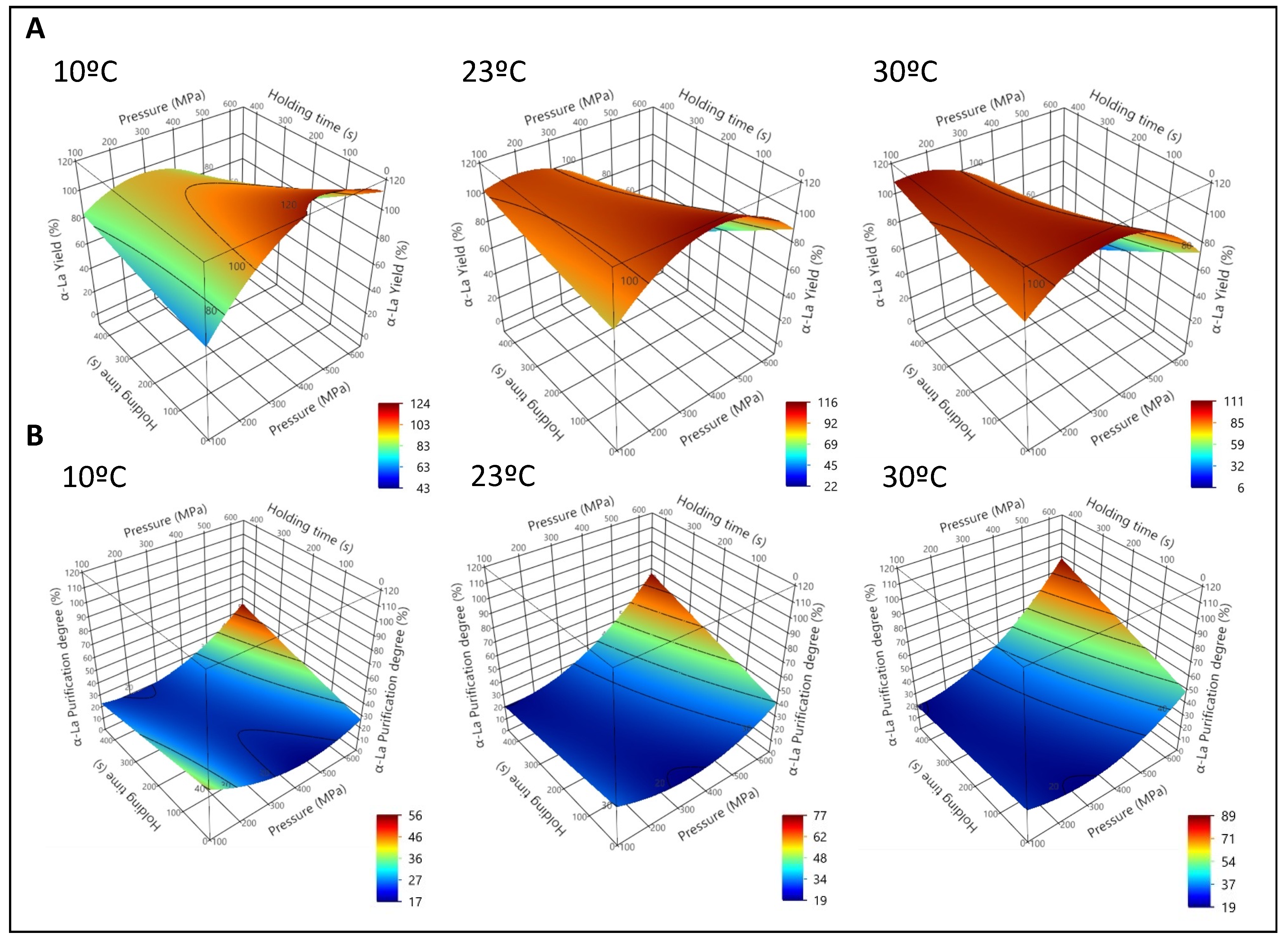
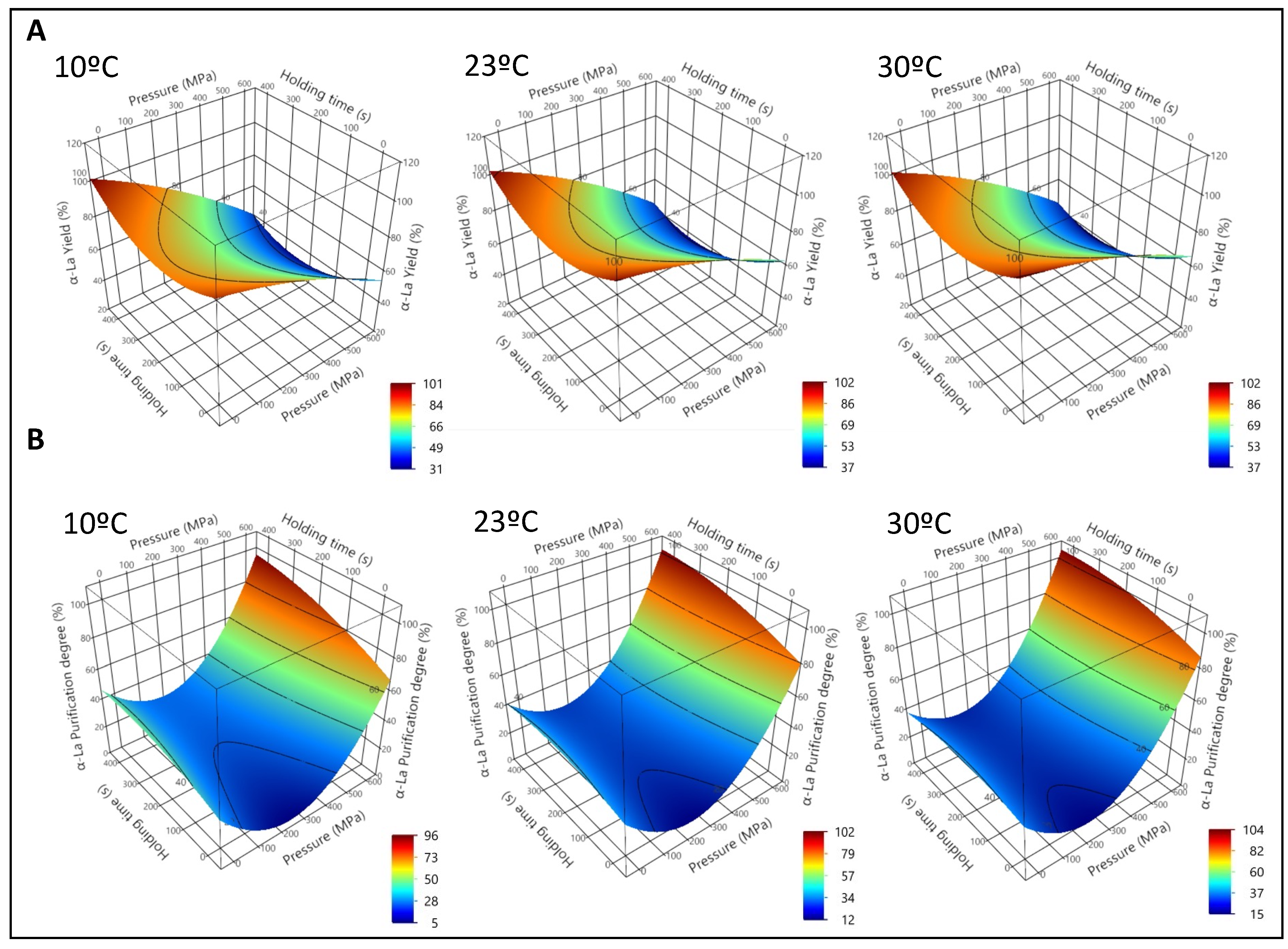
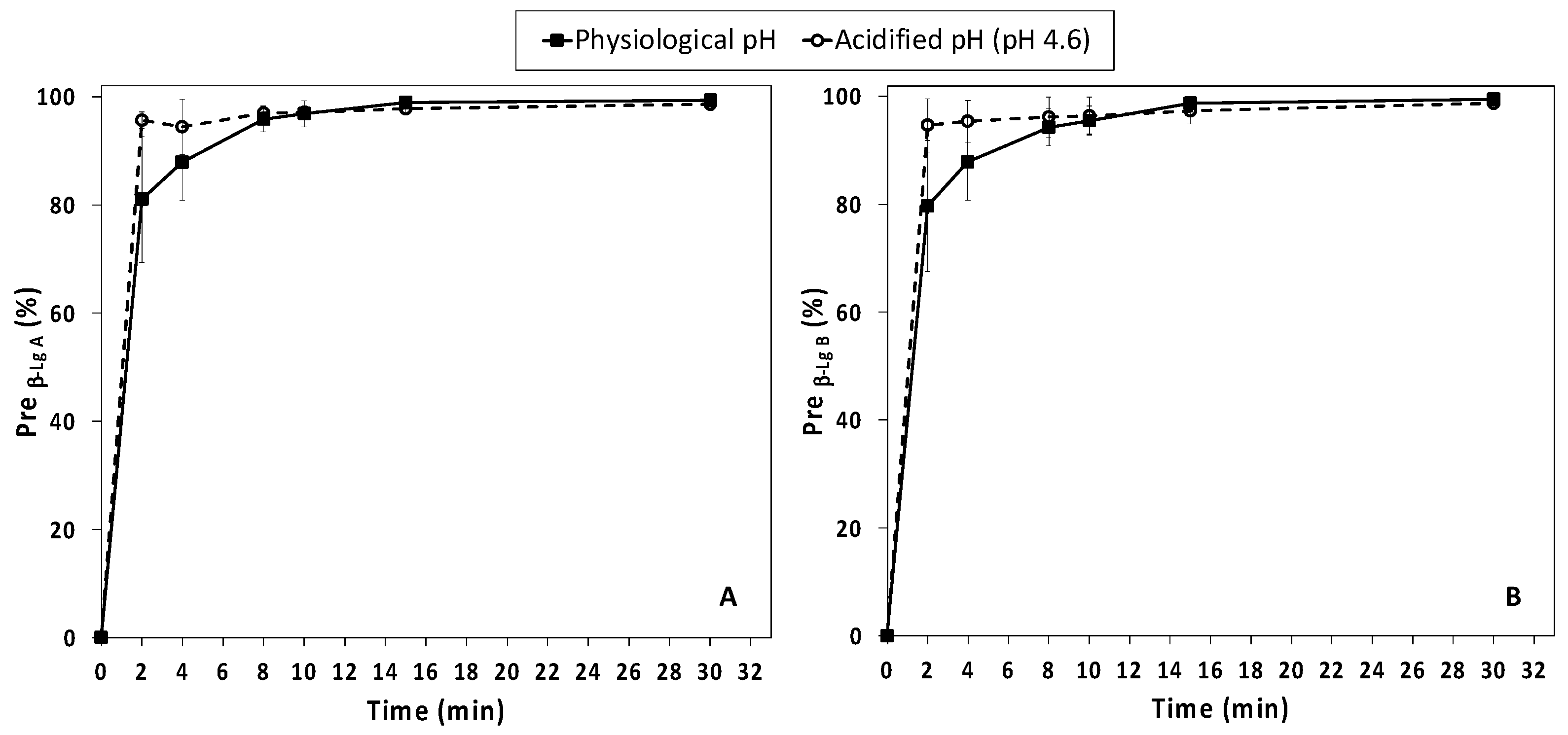


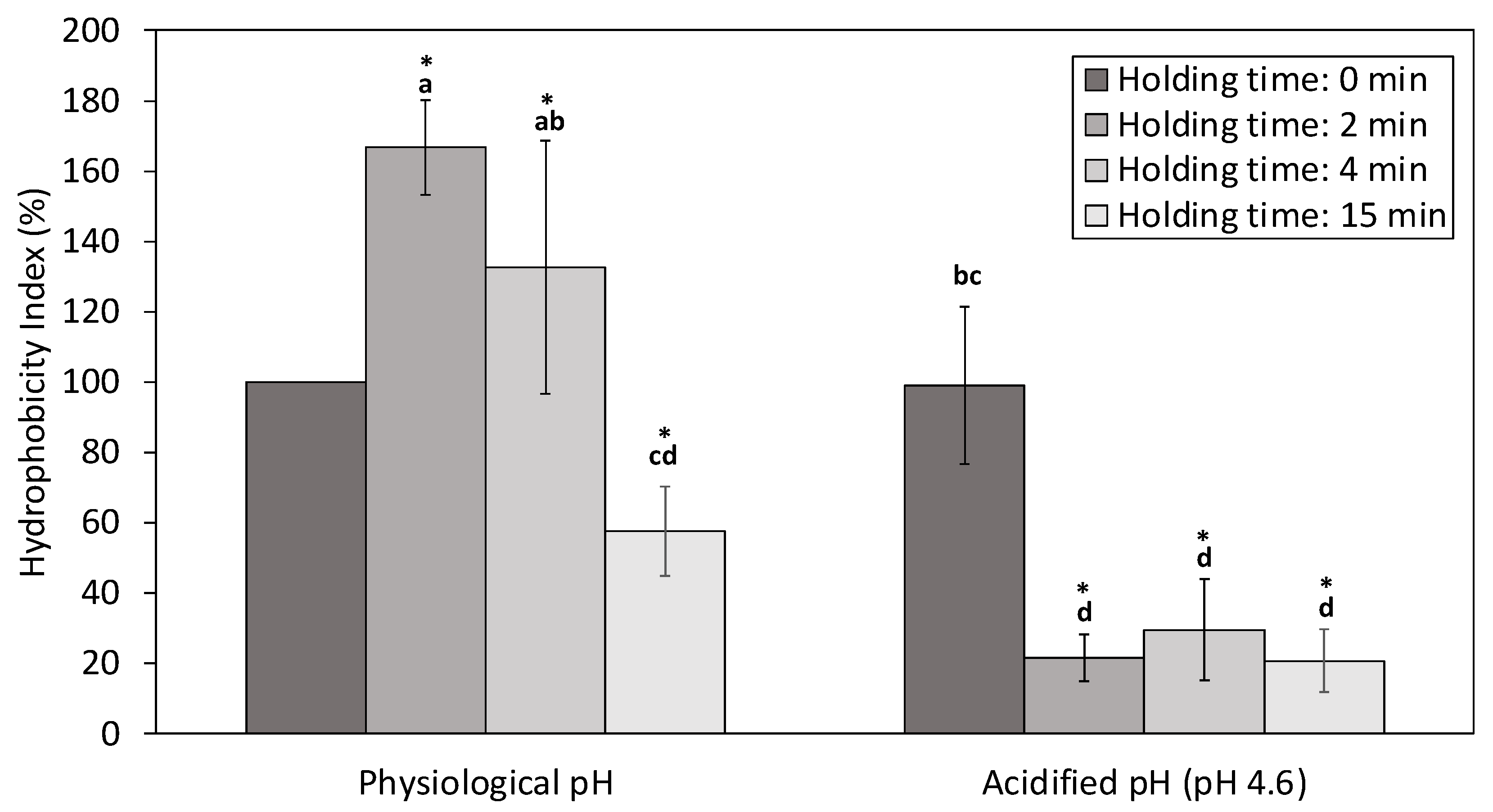
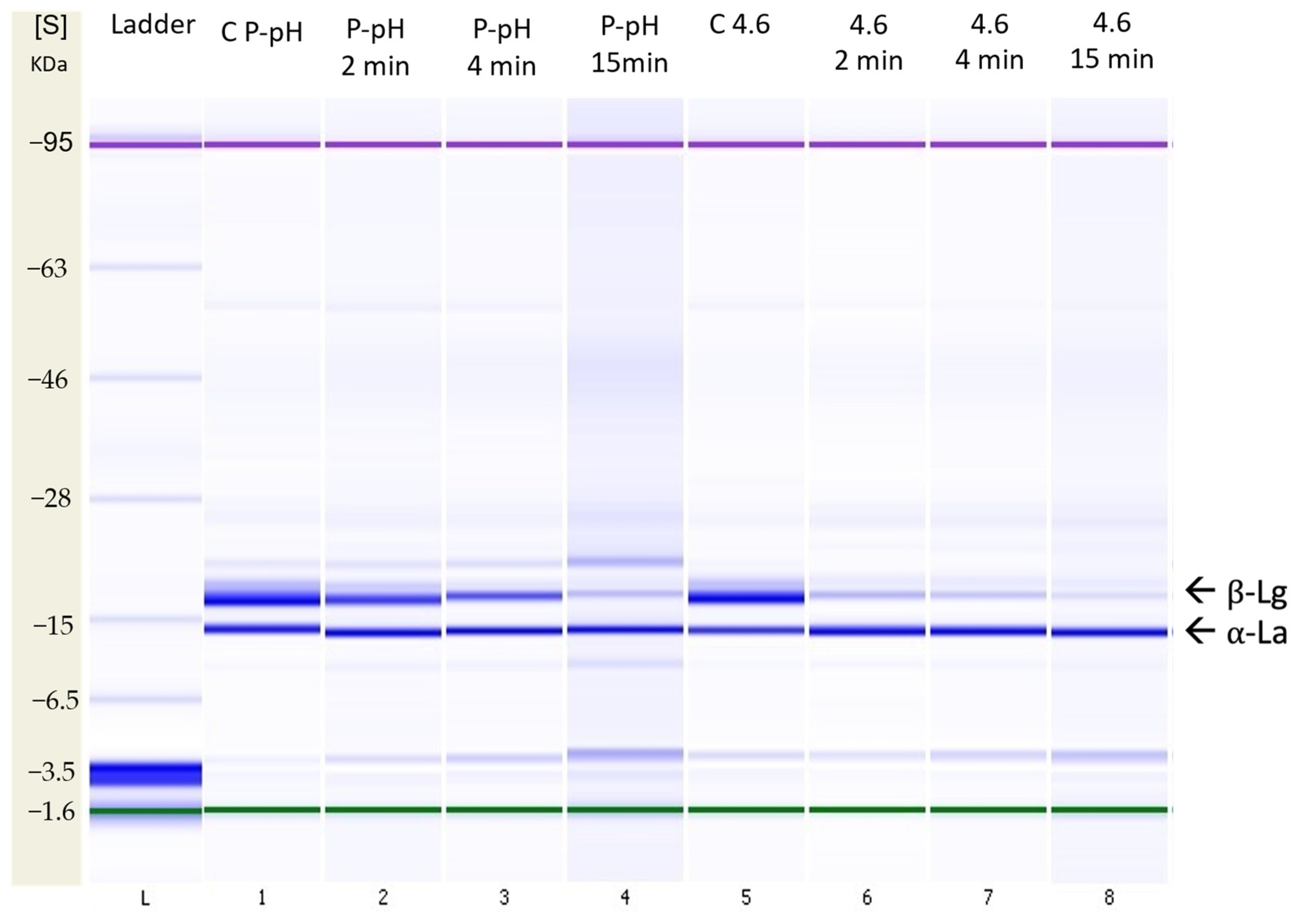
| NWC0 | NWC1 | NWC2 | NWC3 | NWC4 | Mean ± Std. dev. | |
|---|---|---|---|---|---|---|
| Ash (% w/w) | 0.74 | 0.76 | 0.77 | 0.79 | 0.82 | 0.78 ± 0.03 |
| Total dry matter (% w/w) | 19.60 | 18.56 | 19.49 | 20.82 | 24.04 | 20.50 ± 2.13 |
| Lactose (% w/w) | 5.33 | 5.13 | 4.84 | 4.83 | 4.93 | 5.01 ± 0.21 |
| Fat (% w/w) | 0.05 | 0.03 | 0.05 | 0.04 | 0.08 | 0.05 ± 0.02 |
| Protein (% w/w) | 13.48 | 12.64 | 13.83 | 15.20 | 18.67 | 14.76 ± 2.37 |
| pH | 6.55 | 6.44 | 6.53 | 6.56 | 6.64 | 6.54 ± 0.07 |
| Concentration factor * | 28.68 | 23.40 | 24.69 | 26.67 | 33.95 | 27.48 ± 4.13 |
| Physiological pH | Acidified pH (4.6) | |||||||||||
|---|---|---|---|---|---|---|---|---|---|---|---|---|
| P (MPa) | T (°C) | Time (s) | α-La Concentration (mg/mL) | β-LgB Concentration (mg/mL) | β-LgA Concentration (mg/mL) | α-La Yield (%) | α-La Purification Degree (%) | α-La Concentration (mg/mL) | β-LgB Concentration (mg/mL) | β-LgA Concentration (mg/mL) | α-La Yield (%) | α-La Purification Degree (%) |
| Control | 52.62 | 45.23 | 132.44 | - | 22.85 | 50.09 | 43.20 | 126.62 | 78.16 | 22.78 | ||
| 145 | 23 | 240 | 51.83 | 44.67 | 130.16 | 99.02 | 22.87 | 52.14 | 45.01 | 130.85 | 75.91 | 22.87 |
| 200 | 10 | 90 | 49.84 | 43.06 | 125.52 | 93.74 | 22.82 | 52.81 | 45.67 | 132.94 | 78.46 | 22.82 |
| 200 | 10 | 390 | 48.85 | 40.39 | 123.09 | 91.87 | 23.01 | 50.27 | 43.55 | 126.42 | 77.26 | 22.83 |
| 200 | 35 | 90 | 53.91 | 46.16 | 134.97 | 97.74 | 22.94 | 51.19 | 44.19 | 129.21 | 79.10 | 22.79 |
| 200 | 35 | 390 | 55.01 | 46.89 | 137.19 | 104.72 | 23.01 | 55.02 | 47.25 | 138.45 | 85.57 | 22.86 |
| 400 | 7 | 240 | 47.99 | 40.73 | 111.76 | 93.75 | 23.94 | 53.18 | 25.81 | 78.53 | 58.97 | 33.76 |
| 400 | 23 | 47 | 56.23 | 44.53 | 129.73 | 109.11 | 24.39 | 53.48 | 37.37 | 100.19 | 73.63 | 27.99 |
| 400 | 23 | 240 | 51.56 | 35.12 | 103.82 | 97.66 | 27.07 | 54.85 | 29.07 | 69.18 | 62.72 | 35.83 |
| 400 | 23 | 240 | 53.45 | 35.13 | 102.19 | 101.14 | 28.02 | 57.99 | 31.19 | 69.57 | 63.54 | 36.53 |
| 400 | 23 | 240 | 58.76 | 38.98 | 114.46 | 114.98 | 27.69 | 53.18 | 28.67 | 63.63 | 57.31 | 36.56 |
| 400 | 23 | 240 | 57.30 | 37.61 | 109.85 | 108.05 | 27.98 | 55.93 | 29.89 | 66.33 | 58.24 | 36.77 |
| 400 | 23 | 240 | 50.54 | 32.41 | 94.75 | 91.29 | 28.44 | 50.98 | 27.36 | 59.75 | 49.46 | 36.92 |
| 400 | 23 | 433 | 58.84 | 29.98 | 89.86 | 86.55 | 32.93 | 62.00 | 29.86 | 59.55 | 57.89 | 40.95 |
| 400 | 39 | 240 | 55.78 | 24.09 | 71.00 | 84.72 | 36.97 | 50.21 | 25.70 | 48.36 | 52.28 | 40.41 |
| 600 | 10 | 90 | 55.99 | 36.36 | 108.26 | 108.46 | 27.91 | 52.04 | 10.08 | 20.89 | 36.89 | 62.69 |
| 600 | 10 | 390 | 57.19 | 20.17 | 61.32 | 70.51 | 41.24 | 50.15 | 3.91 | 9.33 | 42.60 | 79.11 |
| 600 | 23 | 240 | 52.83 | 11.71 | 36.67 | 51.43 | 52.19 | 51.04 | 2.97 | 6.28 | 41.25 | 84.66 |
| 600 | 35 | 90 | 51.82 | 12.03 | 37.21 | 62.78 | 51.28 | 51.00 | 3.00 | 6.83 | 54.95 | 83.83 |
| 655 * | 35 | 390 | 27.99 | 1.55 | 4.37 | 21.37 | 82.52 | 40.53 | 1.45 | 3.26 | 52.18 | 89.59 |
Disclaimer/Publisher’s Note: The statements, opinions and data contained in all publications are solely those of the individual author(s) and contributor(s) and not of MDPI and/or the editor(s). MDPI and/or the editor(s) disclaim responsibility for any injury to people or property resulting from any ideas, methods, instructions or products referred to in the content. |
© 2023 by the authors. Licensee MDPI, Basel, Switzerland. This article is an open access article distributed under the terms and conditions of the Creative Commons Attribution (CC BY) license (https://creativecommons.org/licenses/by/4.0/).
Share and Cite
Romo, M.; Castellari, M.; Fartdinov, D.; Felipe, X. Separation of α-Lactalbumin Enriched Fraction from Bovine Native Whey Concentrate by Combining Membrane and High-Pressure Processing. Foods 2023, 12, 480. https://doi.org/10.3390/foods12030480
Romo M, Castellari M, Fartdinov D, Felipe X. Separation of α-Lactalbumin Enriched Fraction from Bovine Native Whey Concentrate by Combining Membrane and High-Pressure Processing. Foods. 2023; 12(3):480. https://doi.org/10.3390/foods12030480
Chicago/Turabian StyleRomo, María, Massimo Castellari, Dinar Fartdinov, and Xavier Felipe. 2023. "Separation of α-Lactalbumin Enriched Fraction from Bovine Native Whey Concentrate by Combining Membrane and High-Pressure Processing" Foods 12, no. 3: 480. https://doi.org/10.3390/foods12030480
APA StyleRomo, M., Castellari, M., Fartdinov, D., & Felipe, X. (2023). Separation of α-Lactalbumin Enriched Fraction from Bovine Native Whey Concentrate by Combining Membrane and High-Pressure Processing. Foods, 12(3), 480. https://doi.org/10.3390/foods12030480







